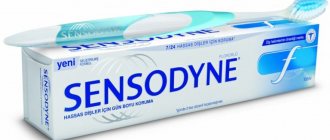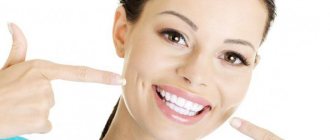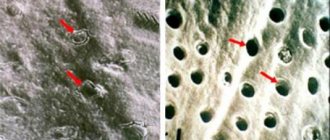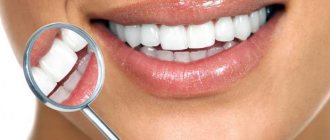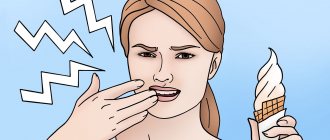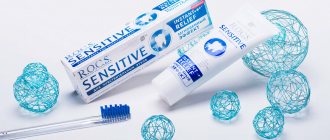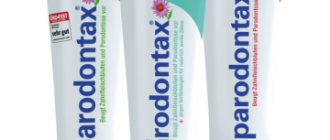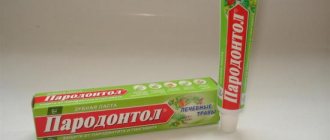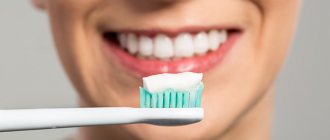From this article you will learn:
- how to choose toothpaste for a child,
- dentist reviews and composition analysis,
- choice between toothpastes with and without fluoride,
- best toothpaste for children - rating 2021.
The article was written by a dentist with more than 19 years of experience.
Children's toothpaste is a very important element of a child's oral hygiene, which must be correctly selected, based primarily on his age, as well as the prevalence of caries (the number of carious teeth in a child). In this regard, all toothpastes for children can be divided into two main groups: 1) fluoride-containing toothpastes, 2) calcium-containing toothpastes (without fluoride). But in addition to calcium or fluorine, the paste may also contain additional components.
Many children's toothpastes contain anti-inflammatory components that facilitate teething (for example, chamomile and calendula extracts, aloe vera, or alginate). The best toothpastes for children also contain xylitol, which has a pronounced anti-caries effect. Many pastes contain enzymes - such as lactoferrin, lactoperoxidase, lysozyme and others, which significantly reduce the risk of a child developing, for example, stomatitis.
Below you can see the rating compiled by our editors, in which you can find children's toothpaste Elmex (Elmex), President, ROKS, Biorepair (biorepair) and SPLAT. For each option, we will analyze the composition and talk about the pros and cons of each product. In addition, before reading the ↓ , please read carefully the following section, which is devoted to important criteria for choosing a toothpaste for a child.
How to choose the right children's toothpaste -
The best toothpaste for children should have a number of important characteristics. Among them, such a criterion as “safety” occupies an important place, because children under 4-6 years of age have not yet developed a full swallowing reflex and may involuntarily swallow a small amount of toothpaste. An important criterion is “anti-caries effectiveness”, because The enamel of children's teeth is poorly mineralized and is therefore particularly susceptible to caries.
1) Abrasiveness of children's toothpaste (RDA) –
The abrasiveness of toothpaste is measured in RDA . Responsible manufacturers always publish this index on the packaging of toothpaste. The optimal abrasiveness of pastes for children from 0 to 3 years old is RDA 20-25. For children from 3 to 6 years old - RDA 45-50, and for children from 6 to 12 years old - RDA 50-60. For children over 12 years of age and adults, RDA 75 is considered optimal. Low-abrasive toothpastes should be avoided, because The main function of an abrasive is to remove plaque.
Low-abrasive pastes do not remove plaque well, which only provokes the development of caries in a child. It can be very difficult to understand the logic of some parents who specifically buy pastes for their children with almost zero RDA. They usually motivate their decision by fear for the safety of their teeth, but at the same time, their children walk around with teeth destroyed by caries or with numerous fillings (?). Modern abrasives have a spherical cut, due to which they do not scratch teeth at all and cannot lead to tooth abrasion - if the recommendations above are followed.
2) Safety of children's toothpaste -
Very often on the packaging of children's toothpaste you can find (in various versions) - “does not contain sodium lauryl sulfate, parabens, preservatives, allergens, PEGs, sugar.” By allergens we mean parabens - these are preservatives that sometimes cause allergic reactions on the mucous membrane. The most important components that should not be in toothpastes for children are parabens and sodium lauryl sulfate.
- Parabens (preservatives) - this group includes methylparaben, ethylparaben, propylparaben, isopropylparaben, butylparaben, isobutylparaben, and benzylparaben.
Although most often you can find methylparaben in toothpaste, less often ethylparaben or propylparaben. Studies show that these preservatives can cause allergic reactions in the oral mucosa - in less than 4% of people. They can enter the body through the skin or gastrointestinal tract (for example, when swallowing toothpaste). There is a lot of shocking content on the Internet that claims that parabens can disrupt the endocrine system by exhibiting estrogenic activity. But this is not entirely true. According to clinical studies, parabens with a small molecular size (methylparaben) do not exhibit estrogenic activity at all. And only parabens with a large molecular size (for example, isobutylparaben) can have estrogenic activity, but even then it is 240,000 times less than estradiol, which is the most active female sex hormone from the group of “estrogens”. Therefore, the amount of harm from parabens is certainly exaggerated, but nevertheless, it will be more beneficial for children if the paste does not contain them, because They can still sometimes cause allergic reactions. - Sodium lauryl sulfate (SLS) is a foaming agent that can be either naturally occurring (derived from palm or coconut oil) or can also be synthetically synthesized. It is added because toothpastes with SLS clean tooth enamel better than toothpastes without SLS. A concentration of less than 2% is considered safe, but toothpaste usually contains 0.5% or 1.0%. Let's see what effects SLS can cause on the mucous membrane, or if involuntarily swallowed.
Studies have shown that lauryl sulfate increases desquamation (squamation) of the epithelium of the oral mucosa, making it thinner. This has its consequences, for example, it increases the permeability of the mucous membrane to chemicals that are soluble in water or oil. Those. anti-inflammatory components (for example, from medicinal plant extracts) will penetrate deeper into the mucous membrane, and this is good.But on the other hand, increased desquamation of the epithelium also has negative sides. For example, it has been clinically proven that the use of toothpastes without SLS by children (compared to the use of SLS-containing toothpastes) has statistically significantly reduced the risk of developing aphthous stomatitis in a child. In the absence of SLS, the number of repeated episodes of aphthous stomatitis and the number of ulcers on the mucous membrane decreased, the pain syndrome was less pronounced, and the ulcers themselves healed faster.
What does it mean? Of course, it is not that SLS causes the development of aphthous stomatitis. Lauryl sulfate simply reduces the thickness of the mucous membrane, making it more sensitive to damaging factors (in particular to allergic reactions, which are the cause of the development of ulcers in aphthous stomatitis). By the way, SLS is a surfactant, and it can enter the body only through involuntary ingestion of toothpaste, as well as through food (it is actually found in some products, and it is safe).
On various forums you can hear hysteria about the carcinogenicity and organ toxicity of SLS, that lauryl sulfate penetrates the bloodstream and causes damage to the liver, lungs and brain. As evidence, they cite the Cosmetic Ingredient Review (CIR) report, which allegedly states this. However, the authors of this report themselves say that their data were misinterpreted (source). In general, do not be fooled by shocking content on the Internet, but rather read clinical studies. Follow the link above - you can familiarize yourself with one of the authoritative studies on this topic using a browser translator.
3) Children's toothpaste with fluoride or calcium (what to choose)
Children's toothpaste with calcium mineralizes teeth well, but due to the lack of fluoride, it does not have an anti-caries effect and does not reduce the risk of developing caries. To compensate for the lack of fluoride, manufacturers began to include xylitol (xylitol) in the composition of such pastes, which also has an anti-caries effect, although not as strong as fluoride. Effective calcium compounds are calcium lactate, calcium pantothenate, calcium glycerophosphate, hydroxyapatite, and it is best when the paste contains a combination of several compounds at once.
You can safely use calcium-containing toothpaste (without fluoride) - in children from 0 to 6 years old under the following conditions. If your child does not have carious teeth, or multiple chalky spots on the teeth (foci of enamel demineralization), or there are only single carious lesions, or you live in a region with a high fluoride content in tap water. If caries develops frequently and fluoride intake is not exceeded, the child needs children's toothpaste with fluoride.
Recommended concentrations of fluoride in toothpaste –
You can find a lot of outdated information on this issue on the Internet. For example, previously toothpastes containing 250 ppm fluoride were recommended for children aged 0 to 2 years. After some time, new recommendations appeared that at this age toothpastes with 500 ppm fluoride are recommended. Currently, toothpastes containing 1000 ppm fluoride are recommended for children aged 0 to 6 years (but the correct amount of toothpaste must be used). The effectiveness and safety of such concentrations are recognized by all leading medical organizations, including:
- "WHO" (World Health Organization),
- "EAPD" (European Academy of Pediatric Dentistry),
- "FDI" (International Dental Association),
- "ADA" (American Dental Association),
- "AAPD" (American Academy of Pediatric Dentistry),
- "AAP" (American Academy of Pediatrics),
- "StAR" (Russian Dental Association), etc.
Table 1 – recommended concentration of fluoride in toothpaste for children. This is data from a very authoritative organization - the European Academy of Pediatric Dentistry (EAPD). Link to scientific publication (source).
The main danger of fluoride is the risk of developing fluorosis, which manifests itself in the form of aesthetic defects of teeth. Fluorosis is associated with an excess intake of fluoride in the body in children under 6 years of age, but the most potentially dangerous period is only from 0 to 2 years (excess fluoride intake after 6 years of age can no longer lead to the development of fluorosis). An important point is that children under 4-6 years of age have not yet developed a normal swallowing reflex - which is why they may involuntarily swallow part of the toothpaste.
Swallowing toothpaste with fluoride can affect the development of fluorosis - only if you live in an area with high levels of fluoride in tap water (or feed your child formula with a high dosage of fluoride). If the dosage of fluoride in drinking water and food is not exceeded, then for a child to develop fluorosis, he will need to swallow about half a tube of toothpaste daily . Thus, the risk of developing fluorosis from swallowing toothpaste is too exaggerated, and it is far from the most important factor in the development of fluorosis.
→ Daily fluoride intake for children
Regions with high levels of fluoride in tap water include some areas of the Moscow region, Kirov, Vladimir, Samara, Ryazan, Tver, Irkutsk, Yaroslavl, Kaluga, Kemerovo regions, as well as Karelia and the Republic of Mordovia (source). The ideal fluoride content in tap water is 0.7 mg/l. Exceeding this indicator to 1.0-1.2 mg/l sharply increases the risk of developing fluorosis. Bottled and mineral water may also have increased concentrations of fluoride (for example, water under the Borisovskaya brand, produced in the Kemerovo region, has fluoride levels ranging from 7.0 to 7.4 mg/l).
It should also be taken into account that water filtration systems operating on the principle of reverse osmosis reduce the fluoride content in water by approximately 84%, and carbon filters by at least 81% (this was proven by research by Brown MD and Aaron G., publication in the journal " Pediatr.Dent" for 1991). Therefore, even if you live in regions with high levels of fluoride in water, your child’s fluoride intake may be within normal limits (the main thing is that you change the cartridges for your filter on time).
Indications for use
ROCS SENSITIVE “Repair & Whitening” toothpaste is recommended for all persons suffering from symptoms of increased tooth sensitivity. Regardless of the reasons for the occurrence of undesirable symptoms (be it age-related changes, cracks and chips of enamel, periodontitis, caries, pregnancy, dietary habits, the result of exposure to aggressive substances, or others), the ROCS SENSITIVE “Restoration and Whitening” paste for sensitive teeth will significantly relieve discomfort after first use.
The paste has low abrasiveness (RDA=40), effectively removes plaque, provides a whitening effect and is fully recommended for regular daily use.
Toothpastes for teenagers from 12 years old –
After age 12, it's time to start using adult toothpastes. You can read about the best anti-caries toothpastes that will prevent tooth decay and loss from the link above. There you will find a rating of the best toothpastes, also compiled by our editors.
However, choosing the right toothpaste for a child is only half the battle. It is equally important to know how to properly brush your child’s teeth depending on age. In addition, using an electric toothbrush is a good way to motivate children over 3 years old to brush their teeth. It allows you to introduce playful moments into a standard oral hygiene procedure and make it interesting. We hope that our article was useful to you!
Sources:
1. Dental education of the author of the article, 2. The European Academy of Pediatric Dentistry (EU), 3. National Library of Medicine (USA), 4. “Journal of Oral Pathology and Medicine” (March 2019), 5. “Pediatric therapeutic dentistry. National leadership" (Leontyev V.).
Positive effect
ROCS SENSITIVE “Repair & Whitening” toothpaste is designed specifically to reduce discomfort, restore enamel and improve the appearance of sensitive teeth. The effectiveness and speed of sensitivity reduction is achieved through three mechanisms of action:
- Mineral restoration of natural (own) tooth structures. Achieved thanks to the high bioavailability of calcium glycerophosphate, which is synthesized in the WDS laboratory using a unique patented technology and is a rich source of ionic forms of phosphate and calcium.
- Restoration and protection of hard dental tissues by activating one’s own physiological processes. The triggering “mechanism” of this process is the high content of magnesium and xylitol in the paste.
- Instantly reduces the symptoms of hypersensitivity of teeth by sealing the tubules of exposed dentin and the smallest enamel defects. This action is provided by hydroxyapatite particles of different sizes and high affinity for tooth tissue.
Thus, toothpaste ROCS SENSITIVE “Restoration and Whitening”:
- quickly eliminates symptoms of hypersensitivity of teeth;
- effectively protects against caries and a number of other dental diseases;
- brightens enamel, returns shine to teeth;
- has prebiotic properties, normalizes the microflora of the oral cavity;
- has very low abrasiveness (RDA = 40, which is lower than most regular toothpastes intended for daily hygiene);
- does not injure tooth enamel and dentin;
- freshens breath.
These positive effects of this toothpaste have been confirmed by laboratory and clinical studies. The formula is protected by patents.
Contraindications
Individual intolerance to individual components included in this toothpaste. It is observed extremely rarely.
GREAT offer from the Personal-care online store: choose and buy ROCS SENSITIVE Restoration and Whitening Toothpaste, 94 g at an ATTRACTIVE price. Fast delivery to Moscow and Russia.
Toothpaste ROCS SENSITIVE Restoration and Whitening, 94 g: instructions for use, customer reviews, characteristics. Large catalog For sensitive teeth on the official website of the manufacturer.
